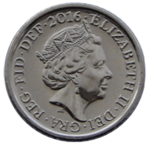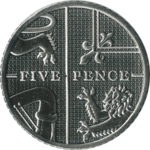
The standard circulating coinage of the United Kingdom, British Crown Dependencies and British Overseas Territories is denominated in pennies and pounds sterling, and ranges in value from one penny sterling to two pounds. Since decimalisation, on 15 February 1971, the pound has been divided into 100 (new) pence. Before decimalisation, twelve pence made a shilling, and twenty shillings made a pound.
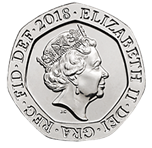
The British decimal twenty pence coin is a denomination of sterling coinage worth 1⁄5 of a pound. Like the 50p coin, it is an equilateral curve heptagon. Its obverse has featured the profile of Queen Elizabeth II since the coin's introduction on 9 June 1982. Four different portraits of the Queen have been used; the latest design by Jody Clark was introduced in 2015. The second and current reverse, featuring a segment of the Royal Shield, was introduced in 2008.
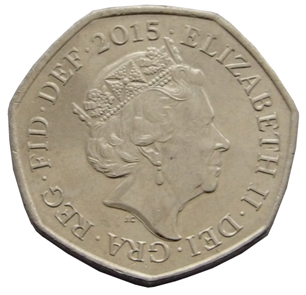
The British decimal fifty pence coin is a denomination of sterling coinage worth 1⁄2 of one pound. Its obverse features the profile of the current Monarch since the coin's introduction in 1969. As of October 2022, five different royal portraits have been used.

The British decimal ten pence coin is a denomination of sterling coinage worth 1⁄10 of a pound. Its obverse has featured the profile of Queen Elizabeth II since the coin's introduction in 1968, to replace the florin coin in preparation for decimalisation in 1971. It remained the same size as the florin coin until a smaller version was introduced 30 September 1992, with the older coins being withdrawn on 30 June 1993. Four different portraits of the Queen have been used on the coin; the latest design by Jody Clark was introduced in 2015. The second and current reverse, featuring a segment of the Royal Shield, was introduced in 2008.
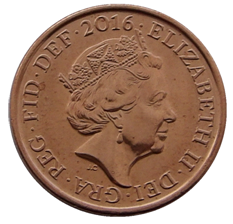
The British decimal one penny (1p) coin is a unit of currency and denomination of sterling coinage worth 1⁄100 of one pound. Its obverse featured the profile of Queen Elizabeth II since the coin's introduction on 15 February 1971, the day British currency was decimalised until her death on 8 September 2022. A new portrait featuring King Charles III was introduced on 30 September 2022, designed by Martin Jennings. Four different portraits of the Queen were used on the obverse; the last design by Jody Clark was introduced in 2015. The second and current reverse, designed by Matthew Dent, features a segment of the Royal Shield and was introduced in 2008. The penny is the lowest value coin ever to circulate in the United Kingdom.

The British decimal two pence coin is a denomination of sterling coinage equalling 2⁄100 of a pound. Since the coin's introduction on 15 February 1971, the year British currency was decimalised, its obverse has featured four profiles of Queen Elizabeth II. In 2008 the design on its reverse changed from the original depiction of a plume of ostrich feathers with a coronet to a segment of the Royal Shield.

The British decimal halfpenny coin was a denomination of sterling coinage introduced in February 1971, at the time of decimalisation, and was worth 1⁄200 of one pound. It was ignored in banking transactions, which were carried out in units of 1p.

The British two pound (£2) coin is a denomination of sterling coinage. Its obverse has featured the profile of Queen Elizabeth II since the coin’s introduction. Three different portraits of the Queen have been used, with the current design by Jody Clark being introduced in 2015. The reverse design features Britannia.

The British one pound (£1) coin is a denomination of sterling coinage. Its obverse bears the Latin engraving ELIZABETH II D G REG F D meaning, 'Elizabeth II, by the grace of God, Queen, Defender of the Faith'. It has featured the profile of Queen Elizabeth II since the original coin's introduction on 21 April 1983. Four different portraits of the Queen have been used, with the latest design by Jody Clark being introduced in 2015. The design on the reverse side of the current, 12-sided coin features four emblems to represent each of the nations of the United Kingdom — the English rose, the leek for Wales, the Scottish thistle, and the shamrock for Northern Ireland, also two or three oak leaves — emerging from a single 5-branched stem within a crown. In May 2022 the Royal Mint announced that the Kenyan-born artist Michael Armitage is designing a new £1 coin which will be issued in 2023 and will celebrate the "history of the UK in the 21st century".

The British florin, or two-shilling piece, was a coin worth 1⁄10 of one pound, or 24 pence. It was issued from 1849 until 1967, with a final issue for collectors dated 1970. It was the last coin circulating immediately prior to decimalisation to be demonetised, in 1993, having for a quarter of a century circulated alongside the ten-pence piece, identical in specifications and value.

The British threepence piece, usually simply known as a threepence, thruppence, or thruppenny bit, was a denomination of sterling coinage worth 1⁄80 of one pound or 1⁄4 of one shilling. It was used in the United Kingdom, and earlier in Great Britain and England. Similar denominations were later used throughout the British Empire and Commonwealth countries, notably in Australia, New Zealand and South Africa.

The British crown was a denomination of sterling coinage worth 1⁄4 of one pound, or 5 shillings, or 60 (old) pence. The crown was first issued during the reign of Edward VI, as part of the coinage of the Kingdom of England.

The threepence or 3d coin was a subdivision of the pre-decimal Irish pound, worth 1⁄80 of a pound or 1⁄4 of a shilling. Leath reul literally means "half reul", the reul being a sixpence coin worth about the same as the Spanish real. As with all other Irish coins, it resembled its British counterpart, as the Irish pound was pegged to the British pound until 1979.
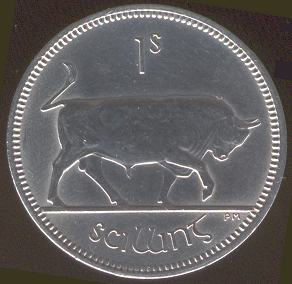
The shilling (1s) coin was a subdivision of the pre-decimal Irish pound, worth 1⁄20 of a pound. Worth 12d or half of a Florin.

The British sixpence piece, sometimes known as a tanner or sixpenny bit, was a denomination of sterling coinage worth 1⁄40 of one pound or half of one shilling. It was first minted in 1551, during the reign of Edward VI, and circulated until 1980. The coin was made from silver from its introduction in 1551 until 1947, and thereafter in cupronickel.

Christopher Ironside OBE, FRBS was an English painter and coin designer, particularly known for the reverse sides of the new British coins issued on decimalisation in 1971.
The threepence or threepenny bit was a denomination of currency used by various jurisdictions in England, Ireland, Scotland and Wales, valued at 1/80 of a pound or 1⁄4 of a shilling until decimalisation of the pound sterling and Irish pound in 1971. It was also used in some parts of the British Empire, notably Australia, New Zealand and South Africa.

The shilling, informally called a "bob", was a type of silver coinage issued by the Commonwealth of Australia, that circulated prior to the decimalisation of Australian coinage. The Australian shilling was derived from the British pre-decimal sterling pound system and was first issued following the passing of the Australian Coinage Act 1909, which established Australia's first formal currency system. The shilling was issued as part of Australia's silver coinage, which included the two-shilling (florin), the sixpence and the threepence. The shilling was minted from 1910 until 1963. During this period there was one significant modification to the design of the Australian shilling, the change in its reverse design, which occurred in 1938 when the design was altered from the Australian Coat of Arms (1910-1936) to the visage of a Merino ram’s head (1938-1963).

The Australian sixpence circulated from 1910 up until the decimalisation of Australian Currency in 1966. The coins were initially minted in England; however, Australia began to mint their own from the year of 1916 at branches of the Royal Mint in Sydney and Melbourne. The coins which made up Australia's pre-decimal currency were identical to British currency in the characteristics of weight and size. The Coinage Act of 1909–1947, authorised the issue of Australian coins in the select denominations, including the sixpence. By 1916 all silver denominations, including the sixpence, could be minted at the Royal Mint branch in Melbourne. Unique Australian currency was created with decimalisation in 1966.
The New Zealand fifty-cent coin is a coin of the New Zealand dollar. It was the largest by denomination, diameter and mass to have been introduced on the decimalisation of the currency on 10 July 1967, replacing the pre-decimal crown coin. A total of 81,585,200 pre-2006 50 cent coins were issued, with a total value of $40,792,600.00
